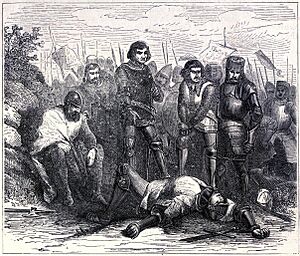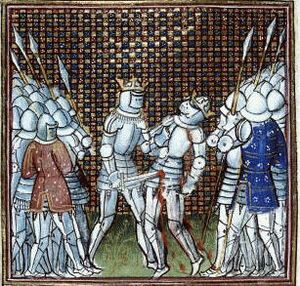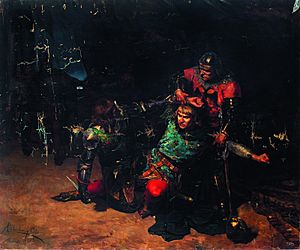Peter of Castile facts for kids
Quick facts for kids Peter |
|
|---|---|
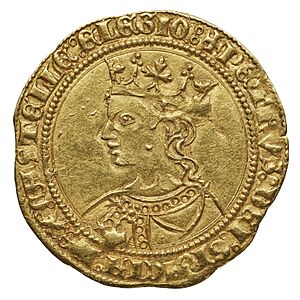
Effigy of Peter on a gold dobla, c. 1350–68
|
|
| King of Castile and León | |
| Reign |
|
| Predecessor | Alfonso XI |
| Successor | Henry II |
| Born | 30 August 1334 Burgos, Castile |
| Died | 23 March 1369 (aged 34) Montiel, Toledo |
| Burial | Seville Cathedral |
| Spouse | María de Padilla Blanche of Bourbon Juana de Castro |
| Issue among others... |
Beatrice, Infanta of Castille Constance, Duchess of Lancaster Isabella, Duchess of York Alfonso, Infante of Castile |
| House | Castilian House of Ivrea |
| Father | Alfonso XI of Castile |
| Mother | Maria of Portugal |
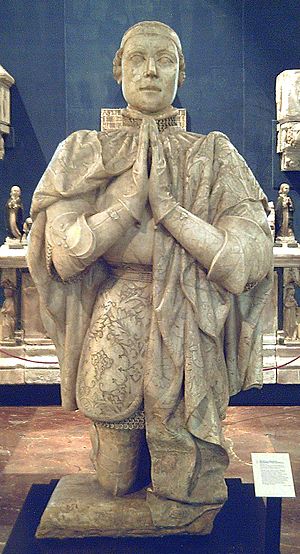
Peter (Spanish: Pedro; born August 30, 1334, died March 23, 1369) was the King of Castile and León from 1350 to 1369. He was sometimes called Peter the Cruel (el Cruel) or Peter the Just (el Justo). Peter was the last ruler from the main line of the House of Ivrea in Castile. He faced many challenges during his rule, including conflicts with the church and wars with his half-brother.
Contents
Early Life and Becoming King
Peter was born in a defensive tower at the Abbey of Santa María la Real de Las Huelgas in Burgos, Spain. His parents were King Alfonso XI of Castile and Queen Maria of Portugal.
According to a writer named Pero López de Ayala, Peter was tall and strong. He had pale skin, blue eyes, and very light blonde hair. He worked hard and enjoyed entertainment, music, and poetry.
When Peter was young, he was supposed to marry Joan, the daughter of King Edward III of England. However, on her way to Castile in 1348, Joan and her group traveled through areas affected by the Black Death. They did not realize how dangerous the disease was. Joan soon became sick and died at age 14.
Peter became king when he was almost 16 years old. At first, his mother, Maria of Portugal, and her advisors had a lot of influence over him. Peter became close to María de Padilla and secretly married her in 1353. Later, Peter's mother and other nobles pressured him to marry Blanche of Bourbon in 1353. Peter left Blanche soon after their wedding. He continued his relationship with María de Padilla, and they had four children together.
Peter also had a brief marriage to Juana de Castro. He claimed his marriage to Blanche was not valid. Peter and Juana were married in Cuellar, and she was declared Queen of Castile. However, Peter left her after only two nights. They had a son who died young. After these events, there was a time of great unrest in the kingdom. Peter was even held captive for a while. But he managed to escape from Toro to Segovia.
In 1361, both Queen Blanche and María de Padilla passed away. After María's death, Peter announced that she had been his only true wife.
Wars and Challenges
From 1356 to 1366, Peter fought many wars with the Kingdom of Aragon. This conflict is known as the "War of the Two Peters" because both kings were named Peter. During this time, the King of Aragon supported Peter's half-brothers against him.
In 1366, a major conflict called the Castilian Civil War began. Peter's half-brother, Henry of Trastámara, led an army against him. Peter retreated several times and eventually left the kingdom without fighting a major battle. He fled to Portugal, where his uncle, King Peter I of Portugal, did not welcome him warmly. Peter then went to Galicia, in northern Spain.
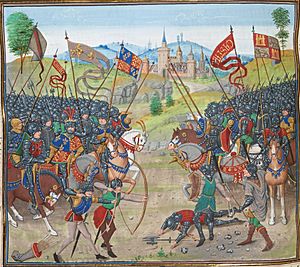
In 1367, Peter received help from Edward the Black Prince, an English prince. With English support, Peter was able to regain his throne after winning the Battle of Nájera. However, the Black Prince's health declined, and he left Spain. He took two of Peter's daughters, Constance and Isabella, with him as a guarantee that Peter would pay for the English help. These princesses later married into English noble families. Constance married John of Gaunt, the Black Prince's brother, which led to English claims on the Castilian throne.
Peter and the Jewish Community
Peter's rival, Henry II of Castile, often tried to turn people against Peter by calling him "King of the Jews." Henry used feelings against Jewish people to gain support. He started attacks against Jewish communities, which led to a period of violence and forced conversions in Castile from about 1370 to 1390. Peter tried to stop these attacks and even punished some leaders who caused riots against Jewish people.
Some people point to Samuel ha-Levi, Peter's treasurer, as proof that Peter supported Jewish people. However, Samuel's success did not mean that all Jewish people in Spain had an easy time. They often faced discrimination and attacks. After Peter's death, Jewish people were forced to wear a yellow badge as a punishment for having supported him.
Death of King Peter
In September 1368, Henry of Trastámara returned to Castile. Many cities, including Burgos and Córdoba, recognized Henry as their new king. Peter, who had gone to Andalusia, decided to fight Henry.
On March 14, 1369, Peter's and Henry's armies met at Montiel, a fortress. Henry won the battle with help from a French knight named Bertrand du Guesclin. Peter hid in the fortress, which remained loyal to him. Peter tried to negotiate with Henry through du Guesclin. Peter offered du Guesclin a large sum of money and several towns to betray Henry. Du Guesclin told Henry about the offer and then made a better deal with Henry to betray Peter instead.
On the night of March 23, 1369, du Guesclin led Peter to his tent, pretending to accept Peter's offer. Henry was waiting there. The historian Pero López de Ayala wrote that Henry did not recognize Peter at first. One of Bertrand's men said, "This is your enemy." Peter then said twice, "I am he, I am he." Henry recognized him and attacked him. Peter's body was left unburied for three days.
Peter's Legacy
People remember King Peter I in different ways. He was one of the few Catholic kings who had a good relationship with an Islamic sultan (from Granada). Granada paid Peter tribute, and he helped them during invasions. One reward he received was a famous ruby, now in the crown of England. It was brought back by the Black Prince along with Peter's two daughters.
Not all of Peter's reputation comes from his enemies. Some people later called him El Justiciero, meaning "the executor of justice" or "the lawful." They said he only punished those who broke the law or did not respect others' rights. Even the writer López de Ayala admitted that many people, including peasants and merchants, were sad about Peter's fall. They felt safer and more secure under his rule.
The English, who supported Peter, also remembered him positively. The famous English writer Geoffrey Chaucer wrote about Peter's death in his work The Canterbury Tales. Chaucer's patron, John of Gaunt, 1st Duke of Lancaster, had fought on Peter's side.
Peter tried to build a strong royal government, which was advanced for his time. However, he struggled to control the powerful nobles who supported his rivals. While he aimed to enforce justice, he sometimes used harsh methods. His death changed the alliance between Castile, Navarre, and England, which had been formed to keep France in check. It also led to the Fernandine Wars, where the Portuguese king claimed the throne of Galicia.
Children
Peter had children with several women. His children with María de Padilla were:
- Beatrice (1353–1369), who became a nun.
- Constance (1354–1394), who married John of Gaunt, a powerful English duke.
- Isabella (1355–1392), who married Edmund of Langley, 1st Duke of York.
- Alfonso (1359–1362). Peter declared Alfonso his rightful heir, but Alfonso was a sickly child and died at age three.
Peter had one son with Juana de Castro:
- John (1355–1405).
Peter also had children with María de Henestrosa, Isabel de Sandoval, and Teresa de Ayala.
See also
 In Spanish: Pedro I de Castilla para niños
In Spanish: Pedro I de Castilla para niños
- Don Pèdre, roi de Castille, a play by Voltaire



